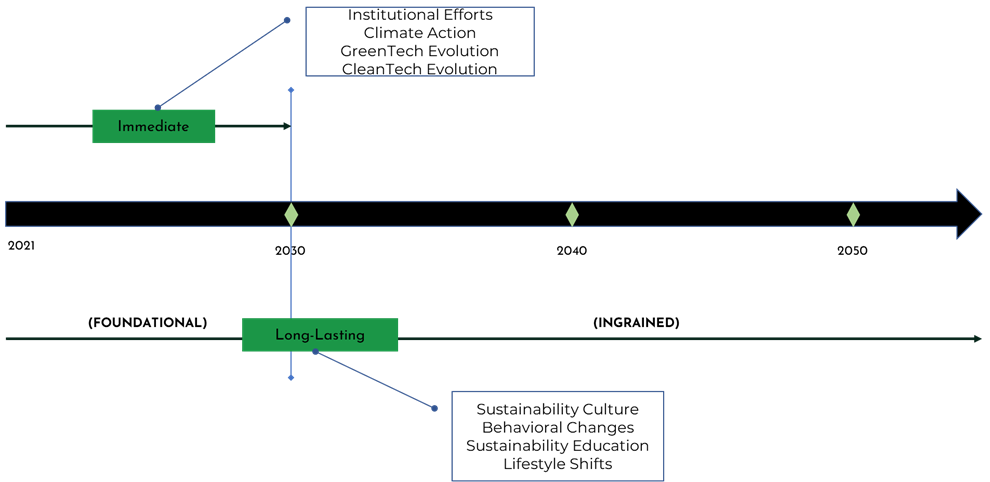
“The ability to meet the needs of the present without compromising the ability of the future generations to meet their own needs”, is the definition of Sustainability provided by the UN, and the one most commonly used to introduce the concept of Sustainability and Sustainable development in today’s day.
Sustainability is three pronged; with Environmental, Social & Economic dimensions. All three stress upon the fact that all resources, be it monetary or planetary, can and will be depleted linearly with their continued usage and must be used in a responsible and conscious manner.
The usage of terms like “Sustainability” and “Sustainable Development Goals” have increased manifold over the past decade, mostly owing to the recent realization and awareness associated with resource depletion and environmental degradation, both byproducts of the Industrial revolution and the population explosion that accompanied it. People today are much more aware and choose to be more eco-friendly. International Organizations and Governments have also been promoting the introduction of sustainability into the daily proceedings of organizations and into the lives of every individual, by increasing the visibility and underlining the importance of the 17 United Nations SDGs. The Paris Agreement, an international treaty which aims to limit the increase in global temperatures, has strengthened the accountability of countries to reduce their emissions and adopt greener practices.
The decade from 2021-2030 is called the ‘Decade of Action’. Immediate climate action needs to be undertaken in this period to address global warming urgently. Alongside these, initiatives should also be taken to help build foundational behavioral changes amongst the people. We must educate and encourage all individuals to make conscious choices today, mitigate the ill-effects of the past, and ensure a livable planet for the future.

How would Schools Introduce Sustainability Education to students seamlessly?
1. Provide Resources for Self-exploration
Sustainable living is being constantly brought-up during conversations in today’s day and age. However, it needs to be recognized that not many children (and adults too) understand what it truly means, both in the theoretical sense and in terms of their future. The best way to introduce students to the concept of sustainability and to ensure that they truly understand its significance is by encouraging them to explore it themselves, rewarding and fueling their curiosity while providing them with tools and content to pique their interest. This could range from sharing short stories, video clips or even podcasts that could be of interest to them.
2. Make Sustainability Fun!
It is essential for students to understand the looming threat that climate change poses to their future, whilst also having the necessary guidance to know what should be done at their end to mitigate it and how they can do it. However, it is very crucial that this sustainability education is provided to students in a light and interactive manner. They must be provided with the confidence that they have the necessary information to act themselves rather than be filled with dread at the idea of saving the planet.
Sustainability should be introduced to them in an easily digestible and fun way so they will be more inclined to imbibe it easily and effortlessly into their lives. This could be done by rewarding their actions and conscious behavior through gamification, apps, or simply giving them the opportunity to witness how their changes impact the bigger picture.
3. Project-based learning
It is a well- established fact that students learn and understand better when presented with visual aids, activities, projects and hands-on learning approaches. Schools can take advantage of these techniques to help impart sustainability education to students and to ensure that the lessons they are being taught drive home.
At Quest conducted a Summer Program for students of classes 5-10 called Summer, Naturally! 2022 which aimed to introduce and educate students on the importance of SDG#12, ‘Responsible Production & Consumption’ and it wound up being an enormous success. We received testimony from multiple teachers stating that the students remained much more responsive and interactive through the length of the program and participated with unwavering enthusiasm.
Moreover, project and activity-based learning tends to add an element of fun to the doom and gloom that generally surrounds the topics of climate change and environmental degradation!
4. Guidance based on Learning inclination
It is very natural for different children to have different subject-based interests. It is the duty of the adults to impart sufficient knowledge and to enable kids to grow their understanding in whichever area of interest they desire to. To ensure that all young learners are processing and understanding what they are taught regarding sustainability in schools, it is paramount that schools and teachers keep track of all students and their developments & achievements. This additionally provides staff the opportunity to identify which subjects are student-favorites and which subjects need to be taught using a different approach.
5. Ensure a 360° understanding of Sustainability
Sustainability is multi-faceted and an introduction of the concept to young minds should always be holistic. This could range from gardening, waste management, travel, shopping choices, biodiversity, energy consumption, waste management, healthy eating etc. Each of these subjects is equally significant and should not be left out. Any Sustainability lessons must also consider the 3 obvious physical spaces where every student spends their day – school, home and outdoors.
Sustainability education must also be imparted in a holistic manner, utilizing traditional modes of teaching inside the classrooms in addition to activity and project based or experiential learning outside the classroom. You could read our blog on ‘4 essentials of holistic sustainability education today’ to understand more.
6. Demonstrate behavior for students to mimic
Schools should start setting examples for students and ensuring their campuses are as sustainable as they possibly can be to help act as a living lab showcasing sustainability to their students. Staff could introduce concepts related to minimalism and the 4Rs in their classrooms, Schools could opt for electric modes of transport and utilize renewable energy sources to power their operations. Additionally, you could check out our blog-post on ‘How to make School campuses Carbon Neutral’.
The Educational System today is nothing like what it was a decade ago. Learning is aimed to be made more inclusive and holistic, including a multitude of skills outside of what is being taught in the classroom. This is endorsed by the National Education Policy of 2020 in India.
Children, unlike full-grown adults, have a totally different perspective and are definitely more in-touch with the natural world. It is up to us to provide them with more opportunities to observe and act accordingly. We need to emphasize their role in climate change mitigation, in a positive and non-threatening manner. But we need them to realize that their future rests on everyone’s daily actions, in the present. We must enable them to develop their ecological identity strongly during their growth years. Where better to do this than at schools - a place where young curious minds spend a majority of their time and are most impressionable?
